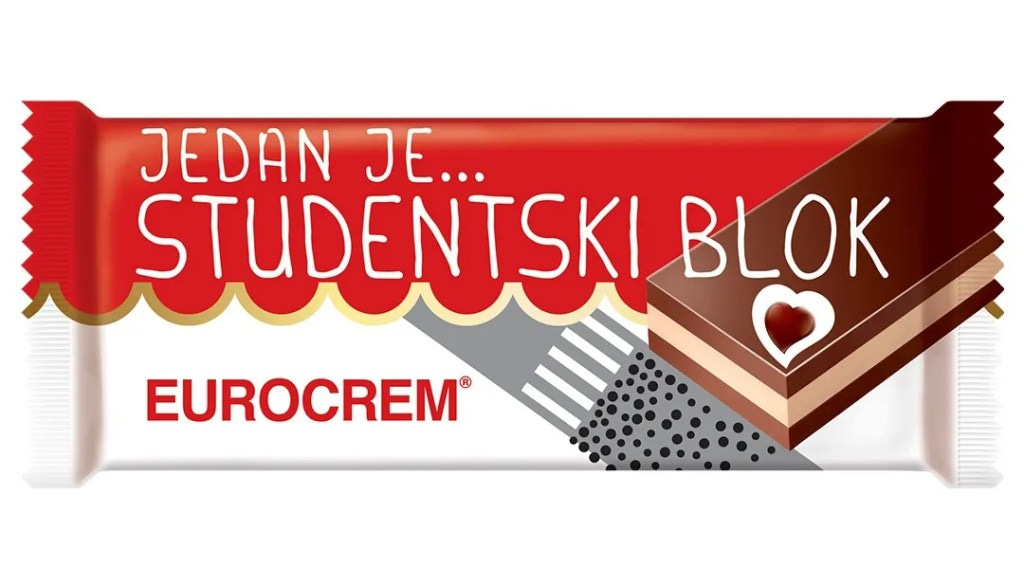Eurocrem: the taste of Serbian Boomer Europeanism
A little history of Serbia's most Europhile spread
My obsession with Eurocrem, Serbia's favorite cocoa and hazelnut spread, started when I was a kid in Belgrade in the 1990s.
I still remember the joy whenever my mom treated me with a small Eurocrem blok, the version of the spread made into a chocolate bar, usually whenever we went into the cavernous Centroprom supermarket by our flat in Zvezdara. The appeal of Eurocrem went beyond the underdeveloped palate of an obese child. In its fancy white and brown packaging, it was a luxury in the mid-1990s, heavily sanctioned and economically destroyed Yugoslavia. Moreover, the "Euro" in its brand offered something a lot of Yugoslavs yearned for - a connection with the West - while "crem" implied refinement and class.
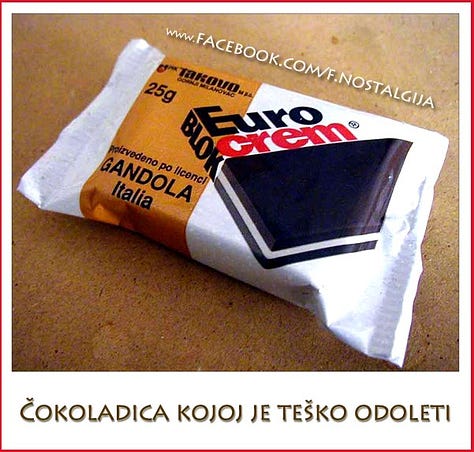
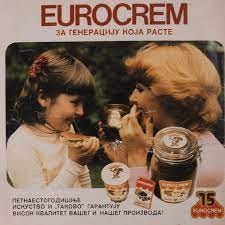
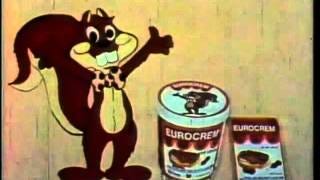

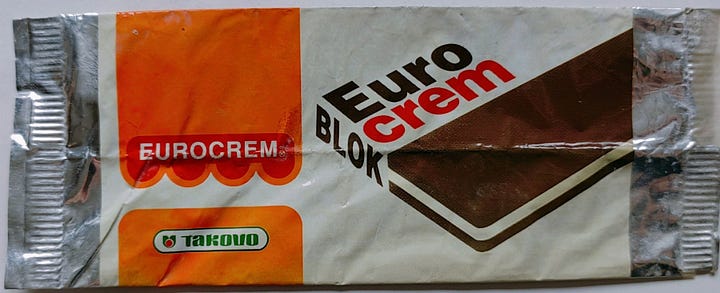
The appeal of the West in Yugoslavia long predated the catastrophic 1990s: it was integral to the national brand and self-reception in the socialist days when the SFR Yugoslavia prided itself on being a non-aligned state that could transact with both Cold War blocks and offer a relatively high level of Western comforts to its citizens in comparison to Warsaw pact states (read more in Radina Vučetić's Coca-Cola socialism and here).
In 1969, Jovan Tomović, an ambitious 37-year-old boss of Gornji Milanovac's Takovo agricultural comibne (kombinat), decided to expand the production of its confectionery arm, which was a nationalized candy and Turkish delight factory founded by the local Milosavljević family in 1941. On a business trip to Italy, Tomović tasted the original Eurocrem spread made by the family-owned Gandola factory located between Brescia and Lake Garda and decided to produce it.
Gandolo's Eurocrem, much like Ferrero's more famous Nutella, was a post-war food made to appease the struggling working and middle classes in Italy and replace them with more expensive chocolate. Both spreads combined the ubiquity of hazelnuts in Northern Italy and the local skill in confectionary (especially gianduia) products to create something that tasted amazing but was relatively cheap to produce in a country that suffered greatly just after WWII. Pietro Ferrero launched his Pasta Gianduja (solid like the original Eurocrem blok) in Alba in 1946, which became creamy in 1951 and was finally rebranded into Nutella in 1964. In the same year, Aldo Gandola entered the growing hazelnut spread market with the equally export-friendly brand Eurocrem. The brand was probably inspired by the ever-increasing faith in European integration and peace, as Italy was the founding member of all post-WWII organizations for European cooperation, and the idea was certainly more optimistic than the reality of Italy described in Malaparte's works.
However, unlike the sleek, monolithic Nutella, Eurocrem had the benefit of presenting the eater with a choice: you had the more cocoa-flavored and softer darker half (my preference), the sweeter and thicker milkier half, or if you are patient enough, you could melt them all into a Nutella-like mass. Maybe this (illusion of) choice appealed to the Yugoslav market. TomoTomović'sitious project of Takovo-produced Eurocrem commenced in 1970. Quickly, Eurocrem became the most popular Yugoslav confectionary product, exported throughout the world, and led to a considerable boost to Gornji Milanovac and its industry.
Just as Eurocrem was taking off, so was the Yugoslav elites yearning for liberalism and Europe. Firstly, the Zagreb spring in 1971, when the Croatian part of the Communist party demanded greater autonomy, and concurrently, in Serbia, where the local “liberal" communists were also pushing for greater Europeanization, until they were ousted in 1972. Around the same time, Vuk Drašković, a talented and ambitious journalist from Herzegovina, was making his name on the local stage and was rising inside the party apparatus. His adventurous, hot temper and charisma helped him in his career but also were a bit of a liability as, in 1978, he was removed from the post of the Yugoslav correspondent from Lusaka, Zambia, due to causing a diplomatic scandal when reporting about the Rhodesian war. A few years later, after Tito’s passing, Drašković sensed an opening in the liberalizing political market; his fiery temper led to him writing books about the corruption in the Yugoslav system, and after going into Serbian nationalism and royalism, becoming arguably the most popular Serbian pro-European dissident and most ardent opposition to Milošević. Indeed, throughout the 1990s, my Eurocrem-loving mother saw Drašković as a savior from the moribund socialist system and somebody who would allow Serbia to rejoin its place among the European nations. His anti-communist, pro-European nationalist SPO was a Serbian version of EU Christian Democrats, our Eurocrem to their Nutella.
Although Drašković suffered politically, because he was not part of the winning DOS coalition against Milošević in 2000, his political and economic influence was still significant even after Serbia struck out on its European course. His brother, Rodoljub, started his Vršac-based confectionary business, SwissLion, in 1997, just as Drašković managed to secure rule for his party in the Belgrade city council. SwissLion rapidly expanded in post-socialist Serbia and, in 2004, privatized and bought Takovo.
Now in charge of the country's most Europhile brand, the Draškovićs started many construction projects, especially in their native Herzegovina. They built a castle-like residence just outside Trebinje while also partnering with the local government to build the Neo-renaissance Temple of Science, Knowledge, and Arts, all from the Eurocrem fortune. They also invested heavily in Herzegovina's tourism and especially the "City of the Sun" project.
For decades, they enjoyed a close connection with governments in Serbia and Republika Srpska, even having Eurocrem wrapped in Vučić branding ahead of the 2022 Presidential election.
However, now, the purveyors of Eurocrem spread seem to have changed tack. After a disagreement with the Dodik government in Republika Srpska, Rodoljub Drašković decided to leave his many philanthropic and business ventures. During the most recent student protests, they issued a pro-protest Eurocrem bloc design.
My quickly expanding waistline led me away from the chocolate and hazelnut spreads, although I shamefully admit that occasionally I fall for Nutella. Those obsessed with ingredients will also point out that the Eurocrem of my youth is no longer what it used to be: whey is used instead of milk, and the ratio of finer ingredients decreased in favor of more palm oil. Thankfully, now there is more choice in Serbia: my friends' family from Vranje produces arguably the tastiest and healthiest mass-produced spread in Serbia, which still retains Italian flair: Amoretti (they even have a vegan/fast-friendly version). Nevertheless, occasionally, I get overwhelmed by nostalgia and I reach for Eurocrem every once in a while. Although it is less tasty or glossy-looking, it symbolizes my youth and, in many ways, our European aspirations.




